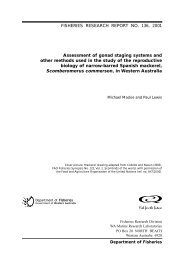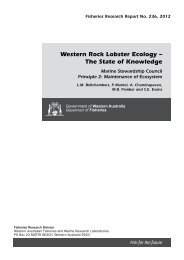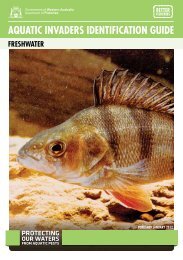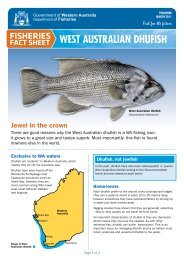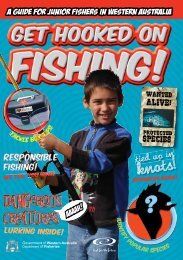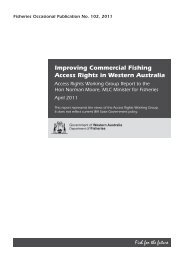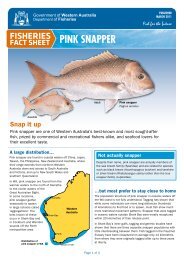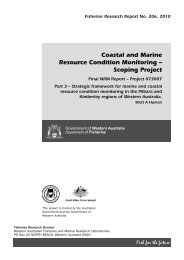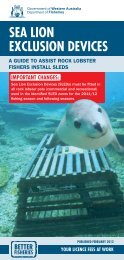Identifying Freshwater Crayfish - Department Of Fisheries Western ...
Identifying Freshwater Crayfish - Department Of Fisheries Western ...
Identifying Freshwater Crayfish - Department Of Fisheries Western ...
Create successful ePaper yourself
Turn your PDF publications into a flip-book with our unique Google optimized e-Paper software.
Features of freshwater crayfish<br />
Carapace: Protective shell covering the<br />
crayfish head and abdomen.<br />
Cervical groove: Semicircular notch that<br />
divides the head of the crayfish.<br />
Chelipeds: The claws of freshwater<br />
crayfish.<br />
Keel: A long ridge that runs lengthwise<br />
Keel<br />
along the top of the head.<br />
Measuring zone: Measure from the tip of<br />
the rostrum to the back of the carapace.<br />
Rostrum<br />
Rostrum: The long spike that sticks<br />
forward from the head between Chelipeds<br />
the eyes.<br />
Telson: The middle ‘panel’ of the tail.<br />
Telson spine: Tail spine found only<br />
on marron.<br />
Uropods: The two pairs of ‘fans’ on<br />
either side of the telson that make up<br />
the tail.<br />
Key to identifying freshwater crayfish<br />
The key is very simple to use. Simply start at point 1 and read<br />
the two choices you have. Decide which of the choices fits the<br />
crayfish best and look below the description. If it provides a<br />
number, then go to that numbered point and again read the<br />
choices. Alternatively, if a name is provided, then you have<br />
matched your crayfish to the likely species.<br />
START<br />
1<br />
SeleCT<br />
3a<br />
Chelipeds (claws) are oval<br />
in shape and quite broad.<br />
Koonac (2 species)<br />
1a<br />
Five obvious keels on the head. Small<br />
spines present on the rostrum.<br />
Go to 2<br />
1b<br />
Four keels on the head but usually<br />
only two keels are obvious. No spines<br />
present on the rostrum at all.<br />
3<br />
SeleCT<br />
Go to 3<br />
3b<br />
Chelipeds (claws) elongated<br />
and quite large. Obvious hairs<br />
on the inside of the ‘elbow’.<br />
Yabby (2 species)<br />
Elbow<br />
Page 2 of 4<br />
Measuring zone<br />
For example, a crayfish has four keels on the head and no<br />
spines on the rostrum. Starting at section 1, this description<br />
fits best with point 1b. After point 1b it says, “Go to 3”. At<br />
section 3, the best fit is 3b, that the claws are elongated and<br />
quite large and there are hairs inside the ‘elbow’. Therefore,<br />
you have successfully identified a yabby.<br />
2a<br />
Two small spines on the telson,<br />
located about halfway up.<br />
Three pairs of small spines<br />
on the rostrum.<br />
Marron (2 types)<br />
Go to 4<br />
4<br />
SeleCT<br />
4a<br />
Middle keel extends all the way<br />
to the cervical groove. Head<br />
covered with short hairs.<br />
Margaret River Hairy Marron<br />
Telson spine Uropods<br />
Carapace<br />
Cervical groove<br />
2b<br />
No spines on the telson.<br />
Two pairs of small<br />
spines on the rostrum.<br />
Gilgie (2 species)<br />
4b<br />
Middle keel does not<br />
extend to the cervical<br />
groove. No hairs on head.<br />
Smooth Marron<br />
Telson<br />
(This is a smooth marron)<br />
Illustration © R.Swainston/www.anima.net.au<br />
2<br />
SeleCT



